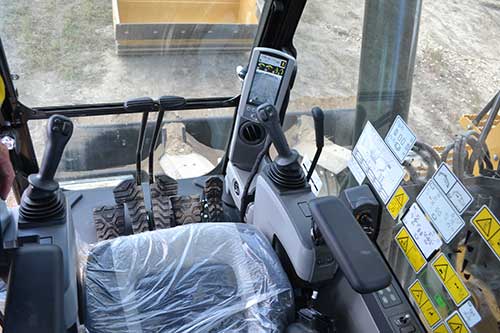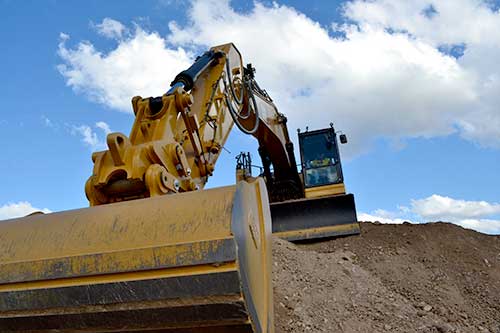The Cat 335F L CR is a compact radius excavator made for heavy work on congested job sites — and sports a very decent blade. Ron Horner takes this 37-tonne earthmover for a test and says its blade makes all the difference.
FOR the past 35 years I’ve been waiting for excavator manufacturers to start putting a decent, large blade on their machines. Every mini excavator you see has one fitted but very few larger models have taken up the challenge.
So when I realised that the Cat 335F L CR 37-tonne excavator had a blade fitted I knew I just had to jump into the cab for a demo.
Now Caterpillar isn’t the first manufacturer of large (ish) excavators to adapt a blade to their range. Volvo and Kobelco are just two which come to mind, however our requests to review one have never come to fruition.
When I approached Cat for a chance to demo the 335F L CR I was greeted with a thumbs up.
I was warmly received by Paul Athey, who heads up the newly constructed Caterpillar Distribution Centre at Yatala in South East Queensland. He opened up the demonstration yard, gave me the keys to the 335F L CR and gave me a nod … “All yours, Ron!”
To say that I was full of anticipation to get into one of these 335Fs would be an understatement. After owning over 50 excavators and being in the industry for 40 years one expects to have seen and done it all … but this day was different.
Now I know some of you tech-heads out there will get all hot and sweaty at the thought of Cat going all-out Tier 4 compliant with this machine as we see Cat getting in ahead of the legislation which will undoubtedly come in to play in the near future.
Others will be taken in by the earthmover’s compact radius (CR) and long (L) undercarriage, which is also so beneficial in a machine of this size (even if it does have a 300mm and 600mm side overhang).
This is all awesome stuff … but for me it’s all about ‘The Blade’!
As I clawed my way all over the machine, concentrating on the shape and design of the blade and frame construction, the heavy undercarriage and the big drive motors, I continually asked myself, “Could this be the one excavator that, in my mind, is a game changer?”
 |
|
Cat has not cut any corners in the 335F excavator’s large cabin.
|
In the cab
The first thing you will realise when getting into the operator’s seat of the Cat 335F L CR excavator is that this is a very large cabin — Cat has not cut corners in any way, shape or fashion.
A large monitor stares you right in the face. At first glance I thought you’d need to be a computer geek to conquer it, but it turned out to be quite simple.
Not all of the information can be sourced from the monitor. It has to be used in conjunction with the other control functions located on the right-hand dash. Cat has thought this one through and, believe me, it is quite impressive.
All of the run-of-the-mill options like AM/FM radio, air-conditioner and 2-way radio are available, plus large storage space, excellent vision from the operator’s Air Ride seat, firm operating controls and a blade control lever tucked in on the right-hand front control panel.
I was impressed by the design of the cabin and low noise levels of this Cat excavator. The outside noise for a machine of this size is down to the absolute minimum.
 |
|
Optional sticks of 8, 10 or 12 feet give the CAT 335F excellent lifting capacity and digging power.
|
On the job
I decided to take the big girl on a trek up over the stockpile located within the demonstration zone. Two-speed travel mode is ample to get the excavator moving at a suitable speed, and when I put the blade in the ground before ascending the stockpile and cutting back to turtle mode I wondered just how much material it would push while climbing the 30-degree incline.
The CAT 335F handled the ‘climb and push’ with ease, as it did with the bulk handling trial I then put it through.
The hydraulics are very powerful and even when I cut the throttle way back to very low revs the operation of the bucket, dipper, slew and boom were very smooth and had no sign of intermittent hydraulic fade.
This machine comes with optional sticks with lengths of 8, 10 or 12 feet, which gives the CAT 335F excellent lifting capacity and digging power. With the Blade placed on the ground there is fantastic stability for digging and lifting for side, front or rear use.
The Caterpillar design engineers have drawn on the Cat bulldozer range for inspiration and have done their homework on the shape of the blade and the unbelievable strength integrated into the fabrication of the blade link arms.
I would be surprised if it failed any test any competent operator could put it through.
The bottom line
There are a couple of things that will bugger you up when running an excavator with a blade to its optimum level.
The shape of the blade is very important, needing a long leading cutting edge and a high back. When in the hands of a competent operator this design allows the material to cut and roll with remarkable production rates and ease of operation with less track stress. The high back enables plenty of material to be pushed forward.
The distance between the back of the blade and the front of the tracks is also very important. If the blade is positioned too close to the tracks overflow material will fall over the back of the blade, foul the floor and create an uneven surface as the tracks drive over it.
Along with this the operator will have difficulty in keeping a floor level if he can’t see the back and side edge of the blade.
In my opinion Cat has failed ever so slightly in this case as the view on the blade is very restricted. It is my opinion that the blade needs to be extended forward of its current positon by between 150mm to 300mm to enable the operator to have better grade control.
Cat has not failed in delivering a set of big drive motors which have no problem in spinning the tracks and effortlessly pushe the rig with a full blade.
I am led to believe the big and beefy undercarriage could well and truly be over spec’d but it is my experience that the operators out there will push everything to the limit.
One thing is for sure … this well-designed CAT stands in a class of its own and will not disappoint any purchaser. I love it.
 |
Bladed excavators: A personal story |
|
It has been over 30 years in the waiting for me but with the Cat 335F L CR I feel that at last a reputable excavator manufacturer has delivered something very close to my heart. During the late ’70s Kato dealer Banbury Engineering held a massive 80 percent excavator market share in Australia and covered a then complete range from 14 to 30 tonnes. Many people would not realise that Banbury was also importing the first mini excavators in Australia, namely the Nissan N3. These first mini excavators held a lot of promise due to their compact nature but Banbury had little to no luck in moving them as they were antiquated in design. Marketing these Nissans became a major issue so a rethink was on the cards and Banbury turned to Kato mini excavators. It was during this period that I was engaged as a demonstrator operator for Kato. I actually laughed when I saw the little 4-tonne Kato 180G (pictured); not because of its size, shape or design but because Kato had attached a blade to the front of the machine. “What on earth do they expect me to do with this?” I asked, as I climbed aboard for my first test run. Little did I know that this particular day would be a game-changer for me. As the prospective clients rolled in for a look at this mini excavator and I became more familiar with it, I started to realise how the blade created greater versatility. I was hooked! I already had a large fleet of Kato excavators and I was so impressed with the concept of the blade that I went and bought two Kato 180Gs that day — the one I demonstrated and the first articulated side-shift boom mini excavator with blade bought into the country. After a couple of months of operation on the Kato 180G I went and saw Banbury and reported on just how versatile the blade had made the excavators and requested they approach Kato Japan and ask if the company would consider adapting blades to the 20-tonne Kato 750B range. Needless to say the request was turned down and I was looked upon as some sort of looney. I was very disappointed in the decision but have always been a great believer in, and advocate of, adapting blades to excavators as most engineers are still failing to understand the pushing power of a tracked excavator with a well-designed blade attached. — RON HORNER |



